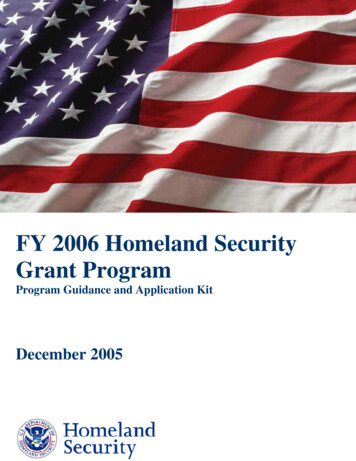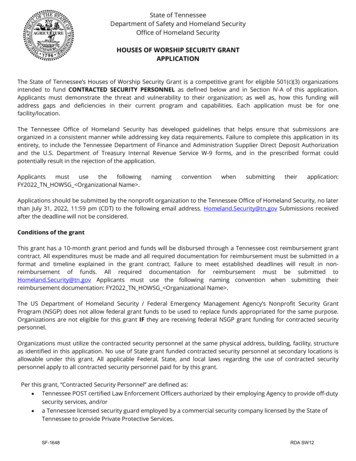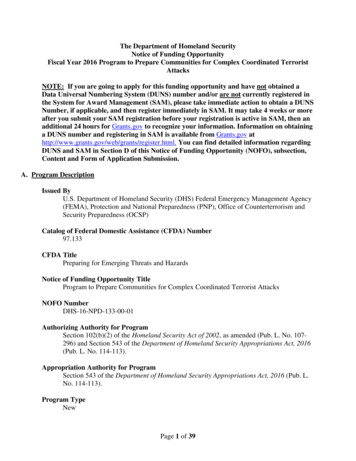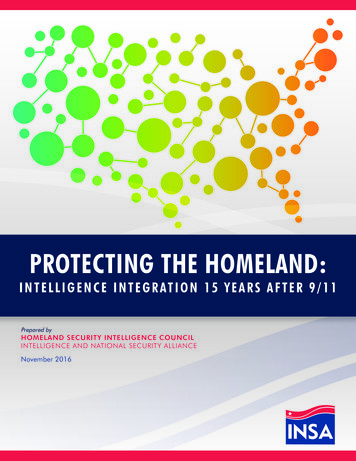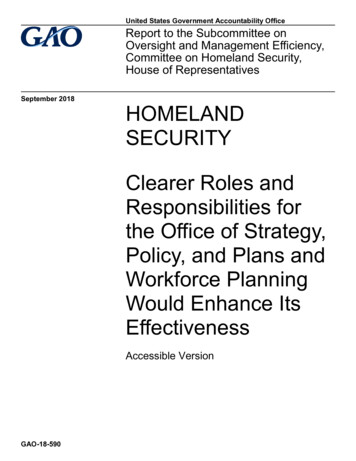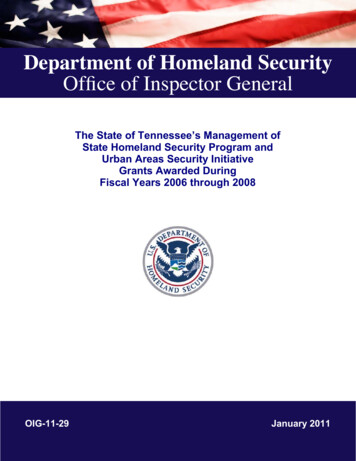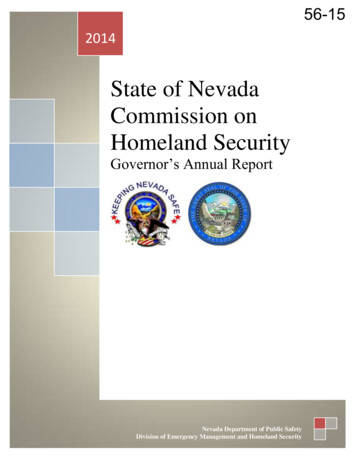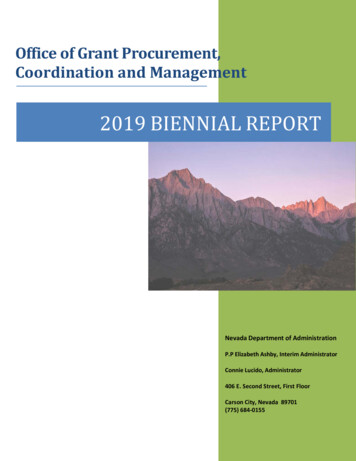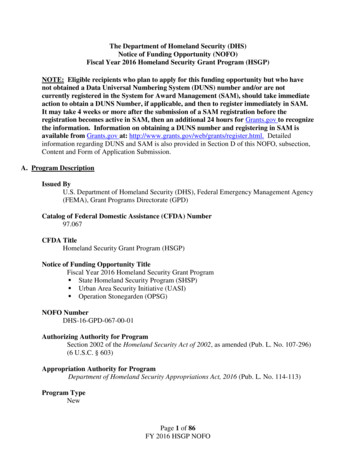
Transcription
The Department of Homeland Security (DHS)Notice of Funding Opportunity (NOFO)Fiscal Year 2016 Homeland Security Grant Program (HSGP)NOTE: Eligible recipients who plan to apply for this funding opportunity but who havenot obtained a Data Universal Numbering System (DUNS) number and/or are notcurrently registered in the System for Award Management (SAM), should take immediateaction to obtain a DUNS Number, if applicable, and then to register immediately in SAM.It may take 4 weeks or more after the submission of a SAM registration before theregistration becomes active in SAM, then an additional 24 hours for Grants.gov to recognizethe information. Information on obtaining a DUNS number and registering in SAM isavailable from Grants.gov at: http://www.grants.gov/web/grants/register.html. Detailedinformation regarding DUNS and SAM is also provided in Section D of this NOFO, subsection,Content and Form of Application Submission.A. Program DescriptionIssued ByU.S. Department of Homeland Security (DHS), Federal Emergency Management Agency(FEMA), Grant Programs Directorate (GPD)Catalog of Federal Domestic Assistance (CFDA) Number97.067CFDA TitleHomeland Security Grant Program (HSGP)Notice of Funding Opportunity TitleFiscal Year 2016 Homeland Security Grant Program State Homeland Security Program (SHSP) Urban Area Security Initiative (UASI) Operation Stonegarden (OPSG)NOFO NumberDHS-16-GPD-067-00-01Authorizing Authority for ProgramSection 2002 of the Homeland Security Act of 2002, as amended (Pub. L. No. 107-296)(6 U.S.C. § 603)Appropriation Authority for ProgramDepartment of Homeland Security Appropriations Act, 2016 (Pub. L. No. 114-113)Program TypeNewPage 1 of 86FY 2016 HSGP NOFO
Program Overview, Objectives, and PrioritiesOverviewThe purpose of the Fiscal Year (FY) 2016 HSGP is to support state and local efforts toprevent terrorism and other catastrophic events and to prepare the Nation for the threatsand hazards that pose the greatest risk to the security of the United States. The FY 2016HSGP provides funding to implement investments that build, sustain, and deliver the 32core capabilities essential to achieving the National Preparedness Goal (the Goal) of asecure and resilient Nation. The building, sustainment, and delivery of these corecapabilities are not exclusive to any single level of government, organization, orcommunity, but rather, require the combined effort of the whole community, inclusive ofchildren, individuals with disabilities and others with access and functional needs, diversecommunities, and people with limited English proficiency. The FY 2016 HSGP supportsthe core capabilities across the five mission areas of Prevention, Protection, Mitigation,Response, and Recovery based on allowable costs. The HSGP supports the QuadrennialHomeland Security Review Mission to Strengthen National Preparedness and Resilience.HSGP is comprised of three grant programs: State Homeland Security Program (SHSP) Urban Area Security Initiative (UASI) Operation Stonegarden (OPSG)Together, these grant programs fund a range of activities, including planning,organization, equipment purchase, training, exercises, and management andadministration across all core capabilities and mission areas.Objectives State Homeland Security Program (SHSP): The SHSP assists state, tribal,territorial, and local preparedness activities that address high-priority preparednessgaps across all core capabilities where a nexus to terrorism exists. All supportedinvestments are based on capability targets and gaps identified during the Threat andHazard Identification and Risk Assessment (THIRA) process, and assessed in theState Preparedness Report (SPR). Urban Area Security Initiative (UASI): The UASI Program assists high-threat,high-density Urban Areas in efforts to build, sustain, and deliver the capabilitiesnecessary to prevent, protect against, mitigate, respond to, and recover from acts ofterrorism. Operation Stonegarden (OPSG): The OPSG Program supports enhancedcooperation and coordination among Customs and Border Protection (CBP), UnitedStates Border Patrol (USBP), and Federal, state, local, tribal, and territorial lawenforcement agencies. The OPSG Program provides funding to support joint effortsto secure the United States’ borders along routes of ingress from international bordersto include travel corridors in states bordering Mexico and Canada, as well as statesand territories with international water borders.All three programs are based on risk-driven, capabilities-based strategic plans that outlinehigh-priority needs relating to terrorism preparedness. For these plans to be effective,Page 2 of 86FY 2016 HSGP NOFO
government officials and elected leaders, working with the whole community, mustconsider how to sustain current capability levels, while also addressing potential gaps.PrioritiesThe National Preparedness System is the instrument the Nation employs to build, sustain,and deliver core capabilities in order to achieve the Goal of a secure and resilient Nation.Complex and far-reaching threats and hazards require a collaborative and wholecommunity approach to national preparedness that engages individuals, families,communities, private and nonprofit sectors, faith-based organizations, and all levels ofgovernment. The guidance, programs, processes, and systems that support eachcomponent of the National Preparedness System allows for the integration ofpreparedness efforts that build, sustain, and deliver core capabilities and achieve thedesired outcomes identified in the Goal. As that Nation works towards achieving theGoal it is important to continue to protect the civil rights of individuals.DHS/FEMA annually publishes the National Preparedness Report (NPR) to reportNational progress in building, sustaining, and delivering the core capabilities outlined inthe Goal. This analysis provides a National perspective on critical preparedness trendsfor whole community partners to use to inform program priorities, allocate resources, andcommunicate with stakeholders about issues of shared concern. Additional informationabout the NPR can be found at the DHS/FEMA’s website ort.In developing applications for the FY 2016 HSGP, recipients are encouraged to considernational areas for improvement identified in the 2015 NPR, which include the followingcore capabilities: Cybersecurity; Infrastructure Systems; Access Control and Identity Verification; Economic Recovery; Housing; and Long-term Vulnerability Reduction.In addition, the Department of Homeland Security requires recipients to prioritizeinvestments that address capability targets and gaps identified through the annual THIRAand SPR process. These assessments set capability targets and measure current ability tomeet those targets.Minimum funding amounts are not prescribed by the Department for these priorities;however, recipients must support state, local, regional, and national efforts in achievingthe desired outcomes of these priorities.Appendix B-Program Priorities addresses additional areas where funding can be appliedto strengthen preparedness efforts.Page 3 of 86FY 2016 HSGP NOFO
B. Federal Award InformationAward Amounts, Important Dates, and ExtensionsAvailable Funding for the HSGP NOFO:HSGP ProgramsState Homeland Security ProgramUrban Area Security InitiativeOperation StonegardenTotal 1,037,000,000FY 2016 Allocation 402,000,000 580,000,000 55,000,000 1,037,000,000For details on program-specific funding amounts, refer to Appendix A – FY 2016Program Allocations.Period of Performance:Thirty-six (36) monthsExtensions to the period of performance (PoP) are allowed. For additional information onPoP extensions, refer to Section H – Additional Information of this NOFO.Projected Period of Performance Start Date:September 1, 2016Projected Period of Performance End Date:August 31, 2019Funding Instrument: GrantC. Eligibility InformationEligible ApplicantsState Governments (State Administrative Agency)Eligibility CriteriaAll 56 States and territories, which includes any state of the United States, the District ofColumbia, the Commonwealth of Puerto Rico, the Virgin Islands, Guam, AmericanSamoa, and the Commonwealth of the Northern Mariana Islands, are eligible to apply forSHSP funds. For those states that are eligible for UASI and OPSG funding, the StateAdministrative Agency (SAA) is the only entity eligible to submit applications toDHS/FEMA on behalf of UASI and OPSG applicants.Eligible sub-recipients under the FY 2016 OPSG Program are local units of governmentat the county level and federally-recognized tribal governments in states borderingCanada, states bordering Mexico, and states and territories with international waterborders. All applicants must have active ongoing USBP operations coordinated througha CBP sector office to be eligible for OPSG funding.Page 4 of 86FY 2016 HSGP NOFO
Eligible high-risk Urban Areas for the FY 2016 UASI Program have been determinedthrough an analysis of relative risk of terrorism faced by the 100 most populousmetropolitan statistical areas (MSAs) in the United States. Sub-awards will be made bythe SAA to the designated Urban Areas identified in Appendix A - FY 2016 ProgramAllocations.Other Eligibility CriteriaNational Incident Management System (NIMS) ImplementationPrior to allocation of any Federal preparedness awards in FY 2016, recipients mustensure and maintain adoption and implementation of NIMS. Emergency managementand incident response activities require carefully managed resources (personnel, teams,facilities, equipment and/or supplies) to meet incident needs. Utilization of thestandardized resource management concepts such as typing, credentialing, andinventorying promote a strong national mutual aid capability needed to support deliveryof core capabilities. Additional information on resource management and NIMS resourcetyping definitions and job titles/position qualifications is on DHS/FEMA’s website l-aid.DHS/FEMA developed the NIMS Guideline for Credentialing of Personnel to describenational credentialing standards and to provide written guidance regarding the use ofthose standards. This guideline describes credentialing and typing processes, andidentifies tools which Federal Emergency Response Officials (FEROs) and emergencymanagers at all levels of government may use both routinely and to facilitatemultijurisdictional coordinated responses.Although state, local, tribal, territorial, and private sector partners—includingnongovernmental organizations—are not required to credential their personnel inaccordance with these guidelines; DHS/FEMA strongly encourages them to do so inorder to leverage the federal investment in the Federal Information Processing Standards(FIPS) 201 infrastructure and to facilitate interoperability for personnel deployed outsidetheir home jurisdiction. Additional information can be found des-tools.Emergency Management Assistance Compact (EMAC) MembershipIn support of the Goal, recipients must belong to, be located in, or act as a temporarymember of EMAC, except for American Samoa and the Commonwealth of the NorthernMariana Islands, which are not required to belong to EMAC at this time. All assetssupported in part or entirely with FY 2016 HSGP funding must be readily deployable tosupport emergency or disaster operations per existing EMAC agreements. In addition,funding may be used for the sustainment of core capabilities that, while they may not bephysically deployable, support national response capabilities such asGeographic/Geospatial Information Systems (GIS), interoperable communicationssystems, capabilities as defined under the mitigation mission area of the Goal, and fusioncenters.Consolidation of Law Enforcement Terrorism Prevention Activities (LETPA)Page 5 of 86FY 2016 HSGP NOFO
Per section 2006 of the Homeland Security Act of 2002, as amended (6 U.S.C. § 607),DHS/FEMA is required to ensure that at least 25 percent (25%) of grant fundingappropriated for grants awarded under HSGP’s authorizing statute are used for lawenforcement terrorism prevention activities. DHS/FEMA meets this requirement, in part,by requiring all SHSP and UASI recipients to ensure that at least 25 percent (25%) of thecombined HSGP funds allocated under SHSP and UASI are dedicated towards lawenforcement terrorism prevention activities, as defined in 6 U.S.C. § 607. The LETPAallocation can be from SHSP, UASI or both. This requirement does not include awardfunds from OPSG. Please refer to Appendix A – FY 2016 Program Allocations forLETPA minimum allocations for SHSP and UASI by jurisdiction. The 25 percent (25%)LETPA allocation is in addition to the 80 percent (80%) pass through requirement tolocal units of government and Tribes, referenced below.The National Prevention Framework describes those activities that should be executedupon the discovery of intelligence or information regarding an imminent threat to thehomeland, in order to thwart an initial or follow on terrorist attack, and provides guidanceto ensure the Nation is prepared to prevent, avoid, or stop a threatened or actual act ofterrorism. Activities outlined in the National Prevention Framework are eligible for useas LETPA focused funds. In addition, where capabilities are shared with the protectionmission area, the National Protection Framework activities are also eligible. Otherterrorism prevention activities proposed for funding under LETPA must be approved bythe FEMA Administrator.Cost Share or MatchCost share or match is not required for the FY 2016 HSGP.D. Application and Submission InformationKey Dates and TimesDate Posted to Grants.gov:February 16, 2016Application Submission Deadline:April 25, 2016 at 11:59:59 p.m. EDTAll applications must be received by the established deadline. The Non-Disaster (ND)Grants System has a date stamp that indicates when an application is submitted.Applicants will receive an electronic message confirming receipt of the full application.In general, DHS/FEMA will not review applications that are not received by the deadlineor consider them for funding. DHS/FEMA may, however, extend the applicationdeadline on request for any applicant who can demonstrate that good cause exists tojustify extending the deadline. Good cause for an extension may include technicalproblems outside of the applicant’s control that prevent submission of the application bythe deadline, or other exigent or emergency circumstances. If there are technical issues,please notify the respective Headquarters (HQ) Program Analyst before the applicationdeadline.Page 6 of 86FY 2016 HSGP NOFO
Anticipated Funding Selection Date:June 29, 2016Anticipated Award Date:No later than September 30, 2016Other Key Dates (see below for additional information)The chart below outlines suggested/estimated deadlines for completing the seven stepsrequired for a successful application submission. These dates are onlyrecommendations and not required as applicants are responsible for planning farenough in advance to complete their application prior to the established deadline.The requirements outlined in the chart below are outside of DHS/FEMA’s purview.Therefore, DHS/FEMA does not guarantee the timeframes for completing thoseprocesses. Failure of an applicant to comply with any of the required steps before thedeadline for submitting their application may disqualify their application from funding.Applicants are encouraged to register early. The registration process can take fourweeks or more to be completed. Therefore, registration should be done in sufficienttime to ensure it does not impact the ability to meet required submission deadlines.EventObtain DUNS NumberObtain valid EINUpdate SAM registrationEstablish an Authorized OrganizationalRepresentative (AOR) in Grants.govSubmit an initial application in Grants.govSubmit the IJ in the Grants Reporting Tool(GRT)Submit complete application in ND GrantsSystemSuggested Deadline For CompletionMarch 18, 2016March 18, 2016March 18, 2016March 18, 2016April 15, 2016*Applicants will receive an electronicmessage confirming eligibility andapproval to submit a full application.April 15, 2016April 25, 2016Address to Request Application PackageApplication forms and instructions are available at Grants.gov. To access thesematerials, go to http://www.grants.gov, select “Applicants” then “Apply for Grants.” Inorder to obtain the application package select “Download a Grant Application Package.”Enter the CFDA and/or the funding opportunity number located on the cover of thisNOFO, select “Download Package,” and then follow the prompts to download theapplication package.Hard copies of the NOFO are not available.In addition, the Telephone Device for the Deaf (TDD) and/or Federal Information RelayService (FIRS) number available for this Notice is: (800) 462-7585.Page 7 of 86FY 2016 HSGP NOFO
Applications will be processed through the Grants.gov portal and DHS/FEMA’s NonDisaster Grants (ND Grants) System.Content and Form of Application SubmissionApplying for an award under this program is a multi-step process and requires time tocomplete. To ensure that an application is submitted on time applicants are advised tostart the required steps well in advance of their submission. Please review the tableabove under “Submission Dates and Other Key Dates and Times” for estimateddeadlines to complete each of the seven steps listed below. Failure of an applicant tocomply with any of the required steps before the application deadline may disqualifytheir application from funding.The steps required to apply for an award are:1. Applying for, updating or verifying the DUNS Number;2. Applying for, updating or verifying the EIN Number;3. Updating or verifying the SAM Number;4. Establishing an AOR in Grants.gov;5. Submitting an initial application in Grants.gov;6. Submitting the IJ in the GRT; and7. Submitting the complete application in ND GrantsFor additional information regarding the DUNS Number, EIN Number, SAM Number,and AOR requirements, please refer to the section below entitled Dun and BradstreetUniversal Numbering System (DUNS) Number, System for Award Management (SAM),and Authorized Organizational Representative (AOR).Unique Entity Identifier and System for Award Management (SAM)Before applying for a DHS/FEMA grant at grants.gov, applicants must have a DUNSnumber, be registered in SAM, and be approved as an AOR.Applicants are encouraged to register early. The registration process can takefour weeks or more to be completed. Therefore, registration should be done insufficient time to ensure it does not impact the applicant’s ability to meet requiredsubmission deadlines.Obtain an Employer Identification Number (EIN)DHS/FEMA requires both the EIN and a DUNS number prior to the issuance of afinancial assistance award and for grant award payment; both EIN and DUNS are alsorequired to register with SAM (see below). The EIN base for an organization is theInternal Revenue Service (IRS) Tax ID number, for individuals it is their social securitynumber, (both the EIN and social security number are nine-digit numbers).Organizations and individuals submitting their applications must correctly differentiatethe EIN from the DUNS since both are nine-digit numbers. If these numbers are notcorrectly identified in the application, a delay in the issuance of the funding award orincorrect payment to a recipient organization may result.Page 8 of 86FY 2016 HSGP NOFO
Organizations applying for an EIN should plan on a minimum of two full weeks to obtainan EIN. For assistance in registering an EIN please contact the IRS helpline.DHS/FEMA cannot assist applicants with questions related to obtaining a current EIN.Obtain a Dun and Bradstreet Data Universal Numbering System (DUNS) NumberThe DUNS number must be included in the data entry field labeled "OrganizationalDUNS" on the SF-424 form. Instructions for obtaining a DUNS number can be found atthe following website: .The applicant must provide a DUNS number with their application. This number is arequired field for all subsequent steps in the application submission. Applicants shouldverify they have a DUNS number, or take the steps necessary to obtain one.Applicants can receive a DUNS number at no cost by calling the DUNS number requestline at (866) 705-5711. DHS/FEMA cannot assist applicants with questions related toobtaining a current DUNS number.System for Award ManagementApplicants applying for grant funds electronically through Grants.gov must register withSAM. Step-by-step instructions for registering with SAM can be found tml. All applicants must register with SAM in order to apply online. Failureto register with the SAM will result in the application being rejected by Grants.govduring the submissions process.Payment under any DHS/FEMA award is contingent on the recipient’s having a currentSAM registration. The SAM registration process must be completed by the applicant. Itis imperative that the information provided by the applicant is correct and current. Pleaseensure that the organization’s name, address, DUNS number and EIN are up to date inSAM and that the DUNS number used in SAM is the same one used to apply for all otherDHS/FEMA awards.SAM registration is a multi-step process including validating the EIN with the IRS toobtain a Commercial and Government Entity (CAGE) code. The CAGE code is onlyvalid for one year after issuance and must be current at the time of application. SAMsends notifications to the registered user via email 60, 30, and 15 days prior to expirationof the SAM registration for the Entity. SAM registration may lapse due to inactivity. Toupdate or renew the Entity records(s) in SAM applicants will need to create a SAM UserAccount and link it to the migrated Entity records.For assistance registering, please go to SAM or call 866-606-8220. DHS/FEMA cannotassist applicants with questions related to registering in SAM or obtaining a currentCAGE code.Authorized Organizational RepresentativePage 9 of 86FY 2016 HSGP NOFO
The next step in the registration process is creating a username and password withGrants.gov to become an AOR. AORs will need to know the DUNS number of theorganization for which they will be submitting applications to complete this process.Applicants must register the individual who is able to make legally binding commitmentsfor the applicant organization as the AOR; this step is often missed and it is crucial forvalid submissions. To read more detailed instructions for creating a profile onGrants.gov visit: OR AuthorizationAfter creating a profile on Grants.gov, the E-Biz Point of Contact (POC) who is arepresentative from the applicant organization listed as the contact for SAM, will receivean email to grant the AOR permission to submit applications on behalf of theorganization. The E-Biz POC will then log in to Grants.gov and approve an individual asthe AOR, thereby granting permission to submit applications. . To learn more aboutAOR Authorization, visit: zationregistration/step-4-aor-authorization.html. To track an AOR status, tml.Electronic SignatureApplications submitted through Grants.gov constitute a submission as electronicallysigned applications. When submitting the application through Grants.gov, the name ofthe applicant’s AOR will be inserted into the signature line of the application.Applicants experiencing difficulties accessing information or who have questions shouldcall the grants.gov customer support hotline at (800) 518-4726 or email grants.gov atsupport@grants.gov.The federal awarding agency may not make a federal award to an applicant until theapplicant has complied with all applicable DUNS and SAM requirements and, if anapplicant has not fully complied with the requirements by the time the federal awardingagency is ready to make a federal award, the federal awarding agency may determine thatthe applicant is not qualified to receive a federal award.Submitting an Initial Application in Grants.govAll applicants must submit their initial application through Grants.gov. Applicants mayneed to first create a Grants.gov user profile by visiting the Get Registered section of theGrants.gov website. Successful completion of this step is necessary for DHS/FEMA todetermine eligibility of the applicant. Applicants should complete this initial step on-linewhich requires completing: Standard Form 424 (SF-424), Application for Federal Assistance, andGrants.gov (GG) Form Certification Regarding Lobbying Form.Page 10 of 86FY 2016 HSGP NOFO
Both forms are available in the Forms tab under SF-424 Family. The initial applicationcannot be started or submitted in Grants.gov unless the applicant’s registration in SAM isconfirmed.The information submitted in Grants.gov will be retrieved by ND Grants, which willallow DHS/FEMA to determine if an applicant is eligible. Applicants are encouragedto submit their initial application in Grants.gov at least ten days before the April 25,2016, application deadline.Applicants experiencing difficulties accessing information should call the Grants.govcustomer support hotline at 800-518-4726 or email Grants.gov at support@grants.gov.DHS/FEMA cannot assist applicants with questions related to registering withGrants.gov.Submitting the Final Application Submission in the ND Grants SystemEligible applicants will be notified by DHS/FEMA after the initial application issubmitted in Grants.gov and asked to proceed with submitting their complete applicationpackage in ND Grants. Applicants can register early with ND Grants and are encouragedto begin their ND Grants registration at the time of this announcement. Early registrationwill allow applicants to have adequate time to start and complete their application.In ND Grants applicants will be prompted to submit all of the information contained inthe following forms. Applicants should review these forms before applying to ensurethey have all the information required: Standard Form 424A, Budget Information (Non-construction); Standard Form 424B, Standard Assurances (Non-construction); and Standard Form LLL, Disclosure of Lobbying Activities.In addition applicants must submit copies of the following in ND Grants: Investment Justification; Standard Form 424 C Budget Information (Construction) Standard Form 424D, Standard Assurances (Construction); and Indirect Cost Agreement if applicable.Applicants needing assistance registering for the ND Grants system should contactndgrants@fema.gov or (800) 865-4076.HSGP Program Specific Application InstructionsInvestment Justification (SHSP and UASI)As part of the FY 2016 HSGP application process for SHSP and UASI funds, applicantsmust develop formal investment justifications (IJ) that address the proposed investments.Each IJ must demonstrate how proposed investments: Address capability gaps identified as State priorities in the most recent SPR(applicable to states only);Page 11 of 86FY 2016 HSGP NOFO
Align to Urban Area, state, and/or regional THIRAs and national priorities, asoutlined in the NPR; andEngage and/or impact the whole community, including children, older adults,pregnant women, individuals with limited English proficiency, individualswith disabilities and others with access and functional needs, and ensure theprotection of civil rights in the building, sustainment, and delivery of corecapabilities.Furthermore, the IJ must clearly identify and explain how the project will assist theapplicant to achieve capability targets under the National Preparedness System. The IJmust explain how the proposed activity will support the applicant’s efforts to: Prevent a threatened or an actual act of terrorism;Protect citizens, residents, visitors, and assets against the greatest threats andhazards;Mitigate the loss of life and property by lessening the impact of futurecatastrophic events;Respond quickly to save lives, protect property and the environment, and meetbasic human needs in the aftermath of a catastrophic incident; and/orRecover through a focus on the timely restoration, strengthening, accessibilityand revitalization of infrastructure, housing, and a sustainable economy, aswell as the health, social, cultural, historic, and environmental fabric ofcommunities affected by a catastrophic incident; and do so in a manner thatengages the whole community while ensuring the protection of civil rightsCompleting Investment Justifications (IJ) in the Grant Reporting Tool (GRT) (SHSPand UASI)The IJ Planning Guide contains the IJ template and instructions for collecting therequired information for investments and projects. A fillable version of the IJ templatecan be obtained from the respective HQ Program Analyst. Additionally, applicantsshould utilize the Project Worksheet to assemble the information required for eachproject, which will facilitate the input of that information into the GRT.For more information on how to complete IJs, refer to the Investment JustificationPlanning Guide located on fema.gov/grants.Instructions for SHSP Applicants must propose at least one and include up to 10 investments as part oftheir investment justification. Applicants must propose at least one project within each investment in their IJ todescribe the activities they would plan to implement with SHSP funds. There is nolimit to the number of projects that may be submitted. Any projects not i
Fiscal Year 2016 Homeland Security Grant Program State Homeland Security Program (SHSP) Urban Area Security Initiative (UASI) Operation Stonegarden (OPSG) NOFO Number . DHS-16-GPD-067-00-01 . Authorizing Authority for Program . Section 2002 of the . Homeland Security Act of 2002, as amended (Pub. L. No. 107-296) (6 U.S.C. § 603)
